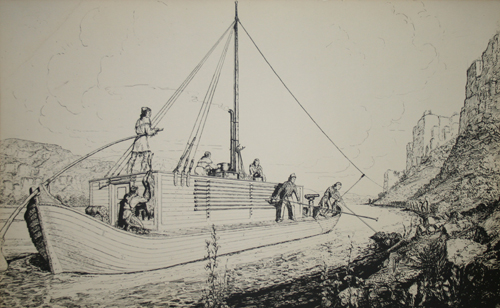
Pen and Ink Drawing of a Keelboat
JEFF-1407
The history of early transportation on the Mississippi River would be incomplete without a discussion of the imporant role of the keelboat. Artifact JEFF-1407 is a well-executed pen and ink drawing by Paul Rockwood which depicts the arduous task of the crew of a keelboat "cordelling" a keelboat on the Upper Mississippi River. When the crew powered a keelboat upstream and the river bottom was unsuitable for travel, a cordelle or towline several hundred feet long was attached to the keelboat and taken ashore by the men who then walked along pulling the boat behind them.
Paul Rockwood was an American graphic artist, printmaker and lithographer who made many drawings of keelboats, flatboats and other view of early transportation on the western rivers. Keelboats were common rivercraft at the beginning of the 19th century. They were large, flatbottomed boats with a heavy timber or keel running down the center of the whole length of the boat. They had a sharp keel, a shaped hull, a rounded bow and stern and a roofed cargo hold and crew cabin. They ranged in size from 40 to 80 feet long and 7 to 18 feet wide. Long poles were used to propel the boat.
Before the advent of the steamboat, keelboats were the dominant boat for upriver travel. They were used extensively for transporting cargo to market, for exploration and trading expeditions for military transport, and for transporting settlers on their journey west. A keelboat could carry up to 300 barrels of freight. It was back breaking work for crews to travel up river, trying to propel the boat against the current. The introduction of the steamboat promptly ended keelboat operations on the main trunk lines because the steamboat could handle taking heavy cargo upstream much better. After the 1820's, keelboats maintly served only the side rivers, while the steamboats carried the growing commerce on the main rivers.
However, keelboats held their place on the tributaries from the 1820's to the 1840's. They continued to work the upper Missouri and upper Mississippi rivers. The tenacity of keelboat operators on the backwaters was due to the fact that they could more easily navigate in periods of low water and in dangerous shallows than the bigger steamboats. Keelboats with their smaller holds could more easily transport small shipments in remote areas, especially in relation to the fur trade and transporting pelts. Keelboats and steamboats become more interdependent. Keelboats could lighten steamboat cargo over shallow waters. In turn, steamboats could tow several keelboats loaded with cargo, upriver, therefore saving costs in labor and capital to keelboat operators. The two forms of early transportation complimented each other.
The difficulties and expense of propelling a loaded keelboat upriver encouraged the search for other methods of transportation on the rivers, hence, the steamboat. But the keelboat men lived on in river lore. Like Paul Bunyan of the woods and Buffalo Bill of the plains, Mike Fink, the king of the rivermen, became a folk hero and a frontier myth.
